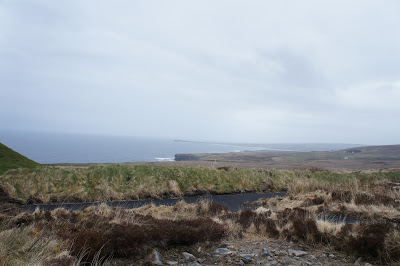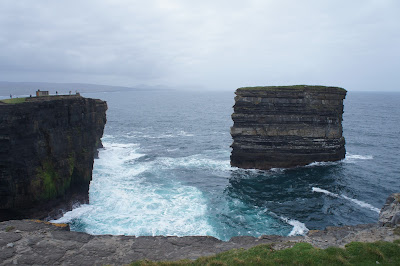Galway ➝ Sligo: "Nobody died." "Winning!"
We have arrived
in Sligo! The trip was a little rougher than the others, though I definitely
kept all the food in my stomach this time thanks to a front row seat. The group
made stops at the Céide Fields interpretive center and archeological site to
learn about the advent of farming in Neolithic Ireland, and then drove on to
Downpatrick Head to see the unique cliff formations there. Despite being a
little nauseous at times, I think today was a pretty cool trip.
I woke up early
to get some breakfast with the early gang (we call ourselves the Breakfast
Club) and to make sure I had enough time to pack. My suitcases are both feeling
the swell of souvenirs, food, and toiletries, so I am welcoming the day that I
get to throw out everything I no longer need and only pack the important stuff.
We loaded all the suitcases on the bus and I got a middle of the bus seat—after
about an hour on the road, I asked to switch with someone up front lest I start
throwing up on the side of the road again. My professor switched with me, so I
got the front of the front seats. The whole windshield was right in front of
me, unobstructed by anyone, and that was a really cool experience when driving
on the small town roads or heading up to the cliffs.
Our first stop
of the day was Céide Fields, an ancient settlement that has an interpretive
center and a guided tour. There is an ancient pine in the rotunda of the
center, which is one of the only remaining from the Neolithic forests that
covered what is now the Wild Atlantic Way of western Ireland. The tour, though
long and outside in the cold, actually provided a lot of interesting
information about the formation of Ireland, the Ice Age events that made the
landscape and fauna what it is today, and the beginning of farming on the
island. Many organic deposits beneath the peat of the present day bog land tell
that there were once animals present within the stone walls buried in the
ground. There is also evidence on the site of milk stored in pottery, which
suggests that the cows were not only just living near the humans, but they were
being used for nutrition. This was the beginning of the lactose tolerance gene
in humans.
The cattle kept
by these people were not actually native to Ireland—they migrated there from
Britain during the Ice Age and remained well after the glaciers melted. The
glaciers also left a wealth of rocks on this landscape, which the people used
to build homes, fences, and animal enclosures around Céide Fields. These
structures are not all unearthed now, but there are many archeologists using
peat probes to work on getting them all above ground. These archeologists have
mapped out the entire village on paper, which our tour guide showed us. As
unimpressive as the piles of rocks look, they actually show the evolution of
farming and the progress of agriculture from thousands of years ago. That’s
pretty amazing.
We grabbed some
quick lunch and then went down to see Céide Cliffs quickly before leaving. Our
tour guide said to be on the lookout for roosting sea birds on the cliffs, and
he was right. There were lots of little families camped out on little sections
of the walls, watching the world go by. The waves made that great sound
crashing against the island, coming back out to sea in a beautiful turquoise color.
The water was so clear that I could see the rocks with seaweed on them down
beneath the surface. It was pretty mesmerizing.
I was one of the last ones admiring the cliff before the bus went back toward Downpatrick Head, an amazing cliff structure with a blowhole and a sea stack. I could smell the sea as soon as I got off the bus—a welcomed scent that remains a comfort to me. The water was still that brilliant blue color, and the waves still made that beautiful crashing sound every time they hit the cliff. The blowhole was a fascinating structure, as nervous as it made me to stand near it. I mean, that part of the cliff did break off at one point, so I think my worry was warranted. The hole was filled with some sort of thick sea foam, probably from all the agitation that water is subject to on any given day. It was a really great example of what the water is capable of doing, and also why people should be extra careful when traveling out on the cliffs.
But what I
really loved at Downpatrick was the sea stack. The little piece of land that
broke off the edge of the cliff was formed back in monastic times. The record
of a giant storm was kept in one of the annals of the local monastery, so that
is when historians assume the stack effectively fell off of the cliff. The
little strip of land left now is almost unfathomable. The groud atop the cliffs
is covered with bog, and then covered again with little clumps of moss. It
looked like Willy Wonka grass, to be honest. All of us started hopping across
on the little tufts like in a video game. It made the whole experience even
more interesting, that’s for sure.
Also great to
watch was the inlet just past the blowhole inlet, where there were arched caves
carved out of the rock. The waves would build and build and then finally create
a mega-wave that crashed against the edge with a huge noise and a flurry of
white foam. I sat on the edge filming and watching for a while, unconcerned
with much other than the sound of the giant waves doing their thing.
By then, it was
time to go back to the bus. I quickly stopped to see the WWII watch tower and
the 1964 EIRA written in stone. These were installed during the “emergency”
period of the war. Ireland was never involved, but the people of the coast
wanted to make sure that there was no way that a bomber could mistake the coast
of Ireland (Eira) for the coast of Britain. The tower was for keeping track of
planes, and the EIRA was a warning to keep on flying until they saw the next
coast. Another fascinating part of history that I got to see!
We all piled
back on the bus and kept driving for another hour and a half, when we arrived
at our hotel in Sligo. About twenty minutes outside the city itself, we started
seeing the landscape structures that we will be visiting later in the week: Knocknarea
mountain and Queen Mebh’s tomb a blip on top of it, Carrowmore Abbey, and
Benbulbin Mountain. I can’t wait to see these awesome landmarks as the days go
by. Sligo seems like a very small town compared to the other places we’ve been,
but our hotel is great and the wifi is holding steady. I have no complaints so
far! We have lass in the morning tomorrow and then time to explore the city,
which should be fun!
♥
photo credit Diana Cleveland & Katie Walker

















































No comments:
Post a Comment